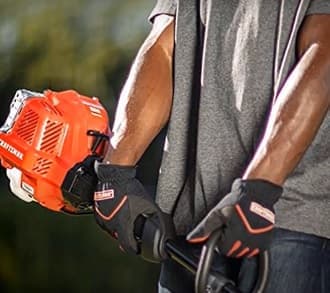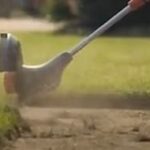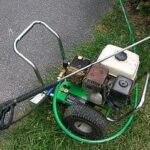As an Amazon Associate, this site earns commissions from qualifying purchases. For more information click here.
Is your string trimmer covered with fuel? You notice the underside and the surrounding areas are all covered by gas even if you have done a small amount of work, or not started yet. There is clearly a problem somewhere but finding out can be a challenge. That is what this guide is written for, to help you find out.
A cracked fuel line is the most likely source of the leak. The carburetor might also have to be cleaned or rebuilt. Other possible causes are a defective fuel cap or cracks in the gas seal.
Important: before you start, have your string trimmer owner’s manual with you. Handling fuel always carries risks so take all the necessary precautions.
Always turn the trimmer off before attempting any inspection or repair. Always do this outdoors or any well-ventilated area. Make sure there are no flammable materials nearby.
Too Much Fuel
This might seem obvious but it is worth checking out. It is possible that you might have poured too much gas in the tank, so the excess is leaking.
String trimmers such as the PowerSmart 25.cc can only take a specific amount of fuel. Too much and the tank may not seal or cause a leak. Turn off the trimmer and open the tank. There should be a line indicating where the limit is. If the fuel is over the indicator and the tank is filled to the brim, it will leak.
This is the easiest one to fix. Remove the excess fuel so only the right amount remains. Turn the trimmer again and there will be no more leaks.
Damaged Gas Lines
The gas line is where the fuel goes after it leaves the tank. This fuel line is typically made of rubber or similar material. Through constant use, the elasticity disappears and it becomes hard. These gas lines then become prone to cracks.
It goes without saying you must never use a cracked gas line. A tiny crack can turn into a huge tear quickly. If your trimmer is covered with fuel residue, there is a good chance the fuel line is damaged.
Replace the gas line immediately if you see any cracks, even small ones. It is a good idea to regularly inspect the gas line (and entire trimmer) regularly so you can take preemptive action.
If you wait too long to replace the gas line, the leaks might spread throughout the engine and cause more damage.
If the gas line already brittle, replace it. Do not wait for the line to crack before taking action. Replacements are available online so it won’t be a problem. It is a good idea to have a reserve hose as it can break down with heavy use.
Cracked Primer Bulb
The primer bulb works with the carburetor and fuel line to make certain the right fuel level goes into the engine. The primer bulb pulls fuel into the fuel line which goes into the carburetor. From there the engine combustion process begins.
There are three signs of a damaged primer bulb: cracks, lack of suction and there is no pressure when you push it. When you see any of these signs, replace the primer bulb.
How to replace a primer bulb:
- Press both sides so the retaining tabs loosen up.
- Take the primer bulb out. You might need to use a prying tool. Most manufacturers also offer primer bulb removal tools to simplify the task.
- Insert the new primer bulb and press the sides to lock the tabs.
That is the basic process and works with most small engines. To be sure, look into your string trimmer manual for details.
Fuel Tank Issues
The fuel cap is also a good place to check for leaks. Even if it is just a small hole, the leak can be substantial. If the trimmer shakes even slightly when you use it, the fuel is going to leak from the cap.
There are many reasons for a leaky fuel cap. It could get punctured by debris when you use the trimmer. If you remove the guard there would be nothing to prevent rocks and other objects from hitting the cap.
The cap could also be lost during maintenance or repair. If the cap was not fastened tight, it could come off while you are using it.
Fuel caps can also get worn out over time. Caps are made of rubber and its elasticity eventually wears off. This causes the seal to loosen and fuel to leak out.
The solution is simple though. Check the fuel cap regularly. Clean the tank and you should be able to see if there are punctures or signs of wear. Replace the cap immediately with a new one.
Dirty or Broken Carburetor
Once you start the engine, the fuel must move from the tank into the carburetor without any interruption or leaks. Any leftover fuel goes back into the reservoir.
For this to work the carburetor must be in good working condition, otherwise the gas will leak. You need to make sure the carburetor is intact before doing any type of work such as cutting weeds.
String trimmer carburetors can get clogged with old fuel residue, which is why fuel has to be replaced every 30 days.
The general rule is that carburetors require cleaning every 3 months. But if your trimmer is heavily used you might need to do it more frequently.
If you are having problems using the string trimmer, check the carburetor. It might be covered in fuel or dirt. A good cleanup should restore its function.
If it does not, the carburetor might need to be rebuilt. There are rebuild kits available that you can use to do this. If there is a fuel leak you have to disassemble the carburetor.

Fuel Sealing Issues
There are two fuel lines in a string trimmer, one for the carburetor and the other to the fuel tank. Both of these have to be sealed. Any tears will cause a leakage.
If there is a leak, turn the engine off. Take a look at the fuel tank. You will see a couple of grommets which are designed to seal the tank.
These grommets have to be airtight to prevent leaks. If the grommets are brittle, this could produce cracks and lead to leaks.
The lines on the carburetor are connected to the outtake and intake valves. These lines can also get cracked or worn out. When it happens expect leaks to occur.
Just like other engine parts, these have to be checked regularly. The best time to inspect these is when you evaluate the fuel lines.
How to Keep String Trimmers in Good Condition
There are several things you can do, but the most important is regular cleaning and maintenance. This alone can minimize any damage caused by gas leaks.
Clean the string trimmer after each use. A good wipe is enough and remove any debris clogging the trimmer head.
Every 3 months, perform a more thorough cleaning. This includes inspecting the engine, the carburetor, fuel lines, filters, gaskets etc. Check each one for signs of wear and tear. The Dasbecan 14 Pcs Carburetor Adjustment Tool Screwdriver kit contains the essential tools you will need for this.
If you notice the primer bulb has turned brittle for example, replace it right away. Do the same with other engine parts.
Use only fuel recommended by the manufacturer. For small engines, regular unleaded with no more than 10% ethanol is fine. Two-stroke engines need a mixture of gas and oil while 4-stroke engines do not.
The air filter has to be cleaned after every 25 hours of use. Remove the cover and wash the filter. If it is covered with oil, there is an oil leak somewhere. You need to find the source of the leak and fix it first. Otherwise, there is no point in cleaning the filter.
Some string trimmer fuel filters can be cleaned, but others have to be replaced. Check the guidelines provided with your weed eater.

I love the outdoors and all the tools for maintaining gardens, yards and lawns. The only thing I am more passionate about is sharing what I know about garden and outdoor equipment.


